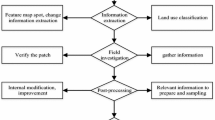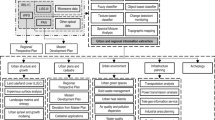Abstract
Physical geography is the foundation of urban social and economic development. The quantity and quality of land resources and their distribution directly affect the economic, social, environmental and comprehensive benefits of the city. Now, in our country, low land use efficiency and irrational land structure in physical geography are both prominent phenomena. One of the main reasons is the lack of scientific and reasonable physical geography land use structure and utilization efficiency plan. Using remote sensing and geographic information system technology, this paper conducts a comprehensive and systematic survey of urban land use changes and obtains land use classification maps for two periods, supports further research and correctly guides people to develop and utilize natural resources and protect the ecological environment and provide powerful reference materials for realizing sustainable land use and sustainable social and economic development. In addition, this article will also introduce multi-source remote sensing image data fusion technology, including fusion information representation, fusion principle, fusion system framework model, fusion algorithm, control and application. By combining ETM remote sensing data with large-scale topographic maps, GIS is used as a supporting tool to construct a spatial database of urban environment, which promotes the development of research.







Similar content being viewed by others
Data availability
Data will be made available on request.
References
Althloothi S, Mahoor M, Zhang X, Voyles R (2014) Human activity recognition using multi-features and multiple kernel learning. Pattern Recogn 47:1800–1812
Anagnostopoulos CE et al (2008) License plate recognition from still images and video sequences: a survey. IEEE Trans Intell Transp Syst 9:377–391
Bilen H, Fernando B, Gavves E, Vedaldi A (2016) Action recognition with dynamic image networks. https://arxiv.org/abs/1612.00738
Chatfield K, Simonyan K, Vedaldi A, Zisserman A (2014) Return of the devil in the details: delving deep into convolutional nets. CoRR. https://arxiv.org/abs/1405.3531
Du S et al (2012) Automatic license plate recognition (ALPR): a state-of-the-art review. IEEE Trans Circuits Syst Video Technol 23:311–325
Feichtenhofer C, Pinz A, Zisserman A (2016) Convolutional two-stream network fusion for video action recognition, In: IEEE conference on computer vision and pattern recognition
Fernando B, Gavves E, Oramas M, Ghodrati A, Tuytelaars T (2017) Rank pooling for action recognition. IEEE Trans Pattern Anal Mach Intell 39:773–787
Gaglio S, Re G, Morana M (2015) Human activity recognition process using 3-D posture data. IEEE Trans Hum Mach Syst 45:586–597
Hu J, Zheng W, Lai J, Zhang J (2015) Jointly learning heterogeneous features for RGB-D activity recognition. In: Proceeding IEEE conference on computer vision and pattern recognition, pp 5344–5352
Karpathy A, Toderici G, Shetty S, Leung T, Sukthankar R, Li F (2014) Large-scale video classification with convolutional neural networks. In: Proceedings IEEE conference of computer vision and pattern recognition, pp 1725–1732
Khaire P, Kumar P, Imran J (2018) Combining CNN streams of RGB-D and skeletal data for human activity recognition. Pattern Recogn Lett 115:107–116
Li C, Hou Y, Wang P, Member S (2017) With convolutional neural networks. IEEE Signal Process Lett 24(5):624–628
Li M, Leung H, Shum H (2016) Human action recognition via skeletal and depth based feature fusion. In: Proceedings 9th international conference on motion in games, pp 123–132
Liu S, Wang H (2018) Human activities recognition based on skeleton information via sparse representation. J Comput Sci Eng 12:1–11
Simonyan K, Zisserman A (2014) Very deep convolutional networks for large-scale image recognition. CoRR. https://arxiv.org/abs/1409.1556
Simonyan K, Zisserman A (2014) Two-stream convolutional networks for action recognition in videos. In: Proceedings 27th international conference on neural information processing systems, 1, 568–576
Triantaphyllou E, Shu B, Sanchez S, Ray T (1998) Multi-criteria decision making: an operations research approach. Encycl Electr Electron Eng 15:175–186
Tu Z, Xie W, Qin Q, Poppe R, Veltkamp R, Li B, Yuan J (2018) Multi-stream CNN: learning representations based on human-related regions for action recognition. Pattern Recogn 79:32–43
Wang J, Liu Z, Wu Y, Yuan J (2014) Learning action let ensemble for 3D human action recognition. IEEE Trans Pattern Anal Mach Intell 36:914–927
Wang P, Li W, Gao Z, Zhang J, Tang C, Ogunbona P (2016) Action recognition from depth maps using deep convolutional neural networks. IEEE Trans Hum Mach Syst 46:498–509
Wang L, Ge L, Li R, Fang Y (2017) Three-stream CNNs for action recognition. Pattern Recogn Lett 92:33–40
Wang P, Li W, Gao Z, Zhang J, Tang C, Ogunbona P (2015) Deep convolutional neural networks for action recognition using depth map sequences https://arxiv.org/abs/1501.04686
Yang X, Zhang C, Tian Y (2012) Recognizing actions using depth motion maps-based histograms of oriented gradients. In: Proceedings of ACM international conference on multimedia, pp 1057–1060
Funding
The authors have not disclosed any funding.
Author information
Authors and Affiliations
Corresponding author
Ethics declarations
Conflict of interest
The authors declare that they have no conflict of interests.
Ethical approval
This article does not contain any studies with human participants performed by any of the authors.
Additional information
Publisher's Note
Springer Nature remains neutral with regard to jurisdictional claims in published maps and institutional affiliations.
Rights and permissions
Springer Nature or its licensor (e.g. a society or other partner) holds exclusive rights to this article under a publishing agreement with the author(s) or other rightsholder(s); author self-archiving of the accepted manuscript version of this article is solely governed by the terms of such publishing agreement and applicable law.
About this article
Cite this article
Xie, Y., Wang, Z., Fan, Y. et al. Application of GIS image system and remote sensing technology in physical geography land planning. Soft Comput 27, 8403–8414 (2023). https://doi.org/10.1007/s00500-023-08128-6
Accepted:
Published:
Issue Date:
DOI: https://doi.org/10.1007/s00500-023-08128-6




